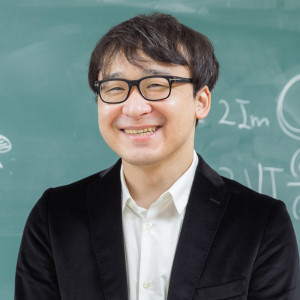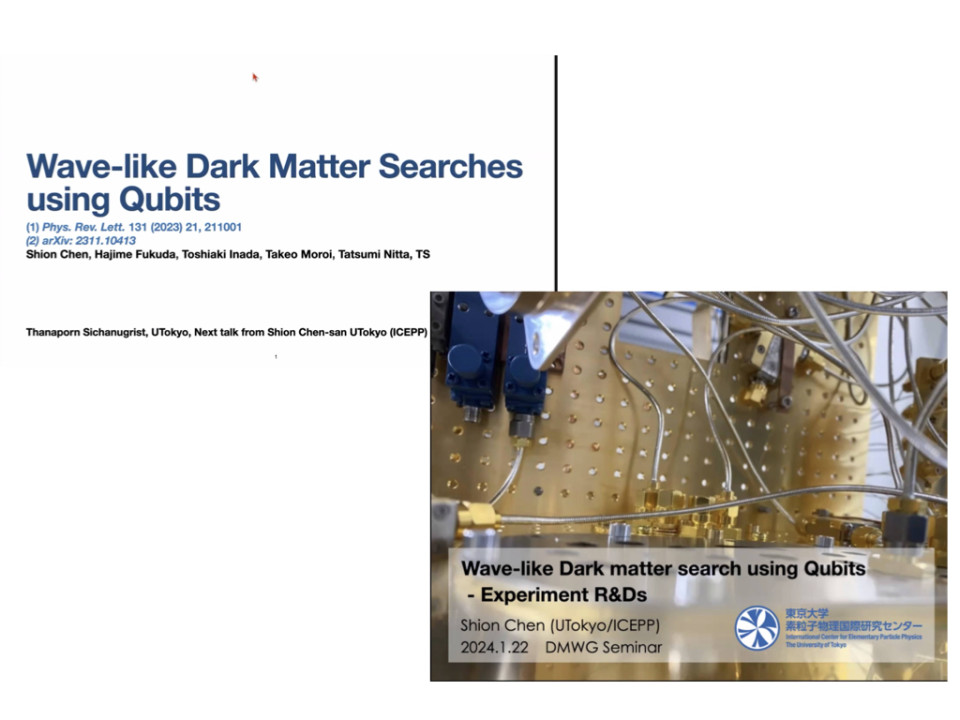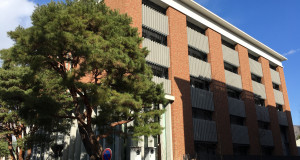Volume 294
Back to Newsletter List
Hot Topic
Farewell message from Hidetoshi Taya
2024-03-13
Our colleague Hidetoshi Taya will move to Department of Physics, Hiyoshi Campus, Keio University as an Assistant Professor, starting from April 1, 2024. We all will miss him and wish him success in his new affiliation! Here is a message from Hidetoshi Taya:
It was truly one of the greatest experiences in my whole life to be able to enjoy science at iTHEMS for four years (including the one year in 2017 as a JSPS posdoc, before joining as an SPDR from 2021). All iTHEMS researchers are so talented and have a broad interest in science, covering almost all topics of science, not only physics, but also mathematics, biology, computational science, etc. The scientific discussions in iTHEMS, therefore, have always been extremely interesting and useful. iTHEMS also gave me a unique opportunity to enhance collaborations through the Working/Study Group program, which I used with NEW (Non-Equilibrium Working Group) and the Theoretical Physics Study Group, and I have learned and enjoyed a lot through their activities. I would like to take this opportunity to express my deep gratitude to the director, Hatsuda-san, the deputy directors, and the assistants, who did/do/are making enormous efforts to achieve the great environment of iTHEMS. Finally, I sincerely hope that iTHEMS will continue to develop and expand its presence, and I look forward to continuing to collaborate and enjoy science with iTHEMS researchers. Thanks for the great four years!
Seminar Report
DMWG Seminar by Thanaporn Sichanugrist on January 22, 2024
2024-03-13
In these years, the study of quantum techniques has been growing so rapidly. New ideas for quantum calculations are being developed, and even the quantum computer will be available in the near future. New quantum tools can be the key to access the physics we have not ever seen.
One example is the application of the two-level qubit to searches of dark matter (DM) of dark photons. When a dark photon enters the qubit system, it behaves as an effective electric field and then excites the qubit. Direct measurements of the excitation of a qubit are already achieved. However, in order to claim the significance, we have to achieve a high signal-to-noise ratio which is, in the simplest setup, proportional to the number of the excited qubits.
The gain can be improved by introducing another quantum nature to such an experiment. By constructing the quantum circuit combining single systems, the signal-to-noise ratio proportional to the square of the number of the excited qubits is obtained. Behind this magic, coherent accumulations of the phase are achieved due to the entanglement effect. Thanks to this enhancement, the sensitivity to dark photon DM can be improved by about two orders of magnitude compared to the case without a circuit.
Further exciting news we have is that such equipment is coming to the real world. Superconducting qubit is realized as an ultra-cold non-linear LC circuit, the readout system is developed using a cavity. The coherence time is important for achieving good readout and it is now rapidly improving. All the system has already been assembled at the University of Tokyo,
meaning that it is ready to operate.
The characterization of the system is now ongoing and discussion of further improvements and enhancement starts. We should see fantastic results in the near future!
Reported by Nagisa Hiroshima
Quantum Enhancement in Dark Matter Detection with Quantum Computation
January 22 (Mon) 16:00 - 18:00, 2024
Upcoming Events
Seminar
DMWG Seminar
Multimessenger probes of superheavy dark matter decay and annihilation
March 26 (Tue) 10:18 - 11:00, 2024
Saikat Das (Postdoctoral Fellow, Yukawa Institute for Theoretical Physics, Kyoto University)
We revisit constraints on decaying very heavy dark matter (VHDM) using the latest ultrahigh-energy cosmic-ray (UHECR; E >1e18 eV) data and ultrahigh-energy (UHE) gamma-ray flux upper limits, measured by the Pierre Auger Observatory. We present updated limits on the VHDM lifetime for masses up to ∼ 1e15 GeV, considering decay into quarks, leptons, and massive bosons. In particular, we consider not only the UHECR spectrum but their composition data that favors heavier nuclei. Such a combined analysis improves the limits at <1e12 GeV because VHDM decay does not produce UHECR nuclei. We also show that the constraints from the UHE gamma-ray upper limits are ∼ 10 times more stringent than that obtained from cosmic rays, for all of the Standard Model final states we consider. The latter improves our limits to VHDM lifetime by a factor of two for dark matter mass >1e12 GeV. We also provide constraints using neutrino flux from dark matter decay, including the neutrino-induced cascades. We consider the interaction of UHE neutrinos with the cosmic neutrino background, leading to the attenuation of the extragalactic flux reaching Earth, which improves our analysis to obtain tighter constraints.
Venue: via Zoom
Event Official Language: English
Seminar
iTHEMS Biology Seminar
Arrhythmic activity rhythms in ants
March 26 (Tue) 16:00 - 17:00, 2024
Haruna Fujioka (Assistant Professor, Faculty of Environmental, Life, Natural Science and Technology, Okayama University)
Most organisms exhibit a periodic activity of about 24 h. This circadian rhythm is considered to be an adaptation to the fluctuations of the environment. In social insects such as honeybees and ants, individual behavior, including activity-rest rhythms, is influenced by interactions within the colony. However, it is challenging to monitor individual activity-rest rhythms in an ant colony due to their large group size and small body size. To address this, we developed an image-based tracking system using 2D barcodes a monomorphic ant and measured the locomotor activities of all colony members under laboratory conditions. Activity-rest rhythms appeared only in isolated ants, not under colony conditions. This suggests that a mixture of social interactions, not light and temperature, induces the loss of activity-rest rhythms. These findings contribute to our understanding of the diverse patterns of circadian activity rhythms in social insects.
References
- Fujioka, Haruna, et al, Ant circadian activity associated with brood care type., Biology letters (2017), doi: 10.1098/rsbl.2016.0743
- Fujioka, Haruna, Masato S. Abe, and Yasukazu Okada, Individual ants do not show activity-rest rhythms in nest conditions., Journal of biological rhythms (2021), doi: 10.1177/07487304211002934
Venue: via Zoom
Event Official Language: English
Special Lecture
Co-hosted by iTHEMS
Kyoto University SACRA-RIKEN iTHEMS Special Lecture by Prof. Tadashi Tokieda
March 28 (Thu) 13:30 - 16:30, 2024
Tadashi Tokieda (Professor, Department of Mathematics, Stanford University, USA)
This event will be conducted in Japanese.
Venue: Large Conference Room, The Kyoto University Tokyo Office
Event Official Language: Japanese
Colloquium
MACS ColloquiumSupported by iTHEMS
The 25th MACS Colloquium
April 19 (Fri) 14:45 - 18:30, 2024
Wataru Morita (Researcher, Department of Anthropology, National Museum of Nature and Science / Associate Professor, Department of Biological Sciences, Graduate School of Science, The University of Tokyo)
14:45-15:00 Teatime discussion
15:00-16:00 Talk by Dr. Wataru Morita (Researcher, Department of Anthropology, National Museum of Nature and Science / Associate Professor, Department of Biological Sciences, Graduate School of Science, The University of Tokyo)
16:15-17:20 2024 Study Group introduction session
17:30-18:30 Discussion
Venue: Maskawa Hall, 1F, Maskawa Building for Education and Research, North Campus, Kyoto University
Event Official Language: Japanese
Workshop
Recent Developments and Challenges in Topological Phases
June 3 (Mon) - 14 (Fri) 2024
Thanks to intensive research efforts, topology has been established as a fundamental concept in physics. For closed quantum systems, the classification of gapped topological phases has matured. Moreover, the importance of topology is not limited to isolated quantum systems. Recently, the topology of non-Hermitian Hamiltonians, which effectively describe systems with dissipation, has attracted much attention worldwide. This fascination is exemplified by topological phases and topological phenomena unique to non-Hermitian systems.
Against this background, the primary purpose of this workshop is to bring together researchers working on topological phases and to discuss (i) open questions in topological phases of closed quantum systems and (ii) the role of topology in open quantum systems and measurements.
Venue: Yukawa Institute for Theoretical Physics, Kyoto University
Event Official Language: English
Upcoming Visitors
March 20 (Wed) - 23 (Sat) 2024 Dongsheng GeProject Researcher, Department of physics, Osaka University Visiting Place: RIKEN Wako Campus |
March 20 (Wed) - 23 (Sat) 2024 Hiromi EbisuPostdoctoral Fellow, Kyoto University Research fields: Theoretical Physics, condensed matter theory, Visiting Place: RIKEN Wako Campus |
Paper of the Week
Week 3, March 2024
2024-03-14
Title: Absence of ground states for anions
Author: Yukimi Goto
arXiv: http://arxiv.org/abs/2403.07642v1
Title: Firewalls at exponentially late times
Author: Andreas Blommaert, Chang-Han Chen, Yasunori Nomura
arXiv: http://arxiv.org/abs/2403.07049v1
If you would like to cancel your subscription or change your email address,
please let us know via our contact form.
Copyright © iTHEMS, RIKEN. All rights reserved.







